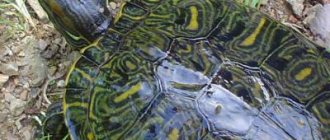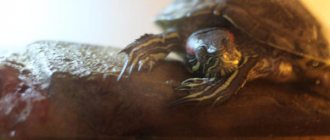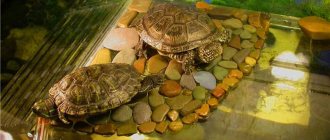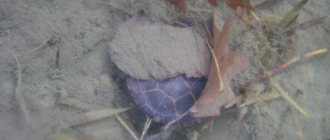Turtles belong to the order of reptiles. In captivity, their life expectancy is up to 50 years. Many breeders want to get offspring from reptiles, but this can only be achieved by creating suitable conditions for turtles. In an unfavorable climate, pets may not show interest in each other throughout their lives. Therefore, it is important to know how turtles mate.
In order to get offspring of red-eared turtles at home, you should create favorable living conditions for them
How does reproduction occur in land reptiles in the wild?
In the wild, turtles begin to breed in the spring - this is a favorable time, since the laid eggs can warm up all summer. It is quite easy to distinguish a male from a female: the former have a small depression on the plastron.
In the wild, in order to attract the attention of a female, males make funny loud sounds, more reminiscent of the yelping of dogs. And in order to win the female’s favor, they fight with each other. The winner receives the main prize - the opportunity to mate. Sexual intercourse of land turtles lasts no more than 10 minutes.
A pregnant turtle carries its offspring for three months. During this time, the female manages to find the right place for laying, which is well warmed up by the sun's rays. In the selected area, the turtle prepares small depressions for eggs (no more than 10 cm deep).
The number of eggs in one clutch may vary, depending on the age of the reptile and its species. It is noteworthy that the older the turtle, the more offspring it has. A pregnant land turtle makes one to three clutches of 70 eggs each. Then she irrigates all the clutches with liquid secreted from the urinary and anal passages. Thus, she eliminates the smell of eggs and protects her cubs from pests.
Newborn turtles, depending on the species, are born after about two months. Some offspring survive the winter underground, in tunnels prepared in advance by turtles, located next to the clutch.
Hatched young turtles immediately begin to crawl towards the water - this is their basic instinct. Relying only on their own strength, not all of them will reach the sea waves. Some will get lost halfway, while others will simply be eaten by seagulls and small predators.
Necessary nuances
In males, puberty occurs earlier around the fifth year of life, while in females in the sixth year. Many people either don’t know this difference or forget about it. Naturally, in this case nothing happens.
If there are several turtles, then it is better when there is one male for several females . This will help avoid conflicts between “boys” and possible injuries. You can understand what sex a reptile is no earlier than it is one year old. Males are smaller in size, but have larger claws and tails. The lower part of the shell also helps to understand the gender - in boys it has a very noticeable “dent”.
For mating, it is recommended to place the female and male in a separate aquarium . It must be filled with clean, settled water. Temperature is extremely important - it should be warmer than the water in the “main” aquaterrarium. The fact is that a change in water and an increase in its temperature are an important additional incentive for red-eared turtles to mate.
In order for turtles to mate, they definitely need water , but the male can get carried away and not allow the female to surface. Therefore, the depth in this “special” aquarium should be small, about 10–12 centimeters.
Before mating, interesting “mating games” take place : the male swims near the female, periodically tickling her face with his claws and hitting her shell with the front edge of his shell. On YOUTUBE you can find a video of exactly how the “flirting” of red-eared turtles occurs.
The duration of sexual intercourse is on average 7–15 minutes. If, after “relocating” to a separate aquarium, the reptiles do not pay attention to each other, then they need to be resettled for a couple of days.
It is better to separate a pregnant female from the male, as he may involuntarily injure her.
Article on the topic: How long can a red-eared turtle be without water, how long will it live on land
The breeding process of domestic land turtles
To start raising reptiles at home, you will need certain conditions. The turtle owner needs to organize:
a strict weekly diet before wintering;
wintering (2 months), after which male and female individuals will become more active and energetic;
removal of gentlemen from females;
after waking up, increase the temperature in the terrarium, thereby forcing the sex hormones of the reptiles to work.
At 7-9 years old, females are ready for the first reproduction, males mature earlier and are ready to mate by the age of six. Males should be placed with females after 7 days from awakening. Males in the new territory will not be so aggressive and will be able to reproduce normally. The owner must closely monitor the cavaliers so that they do not cause serious injuries to each other during battle.
During mating, different types of turtles behave differently, some gently touch their shells, sending vibrations to the female, and more active males prefer to painfully bite the female on the paws and attack her shell.
The partner’s disposition will be immediately noticeable, and she will easily allow the candidate to approach her and will not be against the start of mating. During sexual intercourse, the male climbs onto the female, holding her with his paws. As soon as copulation ends, both partners let out a cry, which means the end of the act. Successful fertilization occurs after 2-3 sexual intercourse, so owners of reptiles should not rush to transfer the male to another terrarium.
While the pregnant turtle is bearing its offspring, the owner needs to take care of the following details:
prepare a container with sand in which the female will lay eggs;
Set up an incubator to keep small reptiles, about 2-3 months after birth. The temperature should not exceed 30 degrees, and the humidity should not be lower than 80%;
review the pregnant woman’s diet, double the amount of food, add vitamin and mineral supplements.
The approach of childbirth can be judged by the behavior of the female. She becomes more restless, refuses to eat and begins to dig holes in the sand.
As soon as the eggs are laid, it is better to move them to an incubator, where the necessary humidity and temperature conditions will be maintained.
Egg care
You cannot leave the eggs in the aquarium. It must be carefully transferred, without turning it over, into an incubator with a temperature of +25...30°C. You can also put the eggs in a jar filled with sand and place them near the central heating pipes.
Eggs from a red-eared turtle clutch should be placed in a container with sand, the temperature in which should be around +25...30C
If it was not possible to observe the reptiles and there are doubts whether the clutch is fertilized, you can consider it. On the first day, a fertilized egg is homogeneous when exposed to light, with a dark dot in the center. After 2-3 months the embryo is visible. If there are no inclusions, the cubs will not appear. It is not recommended to change the position of the eggs unless necessary.
Turtles hatch in 2-5 months. Their size on average is 28-32 mm in length and 30 mm in width, and their weight reaches 4-6 grams. For at least a year, young reptiles should not be allowed into an aquarium where adults are kept, which can injure babies. Females lack maternal instinct.
When the turtles completely get rid of the yolk sac, they should be given the following food :
- chopped fish;
- bloodworms, daphnia, gammarus;
- shrimp.
In this video you will see an overview of the red-eared slider:
This food contains a lot of vitamin D3 and calcium. These microelements prevent the occurrence of respiratory diseases and eye problems. An island of soil is needed, well illuminated by a special lamp.
Breeding turtles in captivity is possible if done responsibly. It is important to monitor the condition of reptiles and the conditions in which they are kept. Particular attention should be paid to immature young turtles.
Breeding problems
Any turtle breeder faces breeding problems. The most common mistakes are:
unfertilized eggs. In the absence of males, turtles lay “empty” eggs. Only after copulation does conception and successful laying occur;
failure to maintain humidity and correct air temperature in the terrarium;
the absence of mating games negatively affects the interest of males in young females. The partner must win the female, become the winner and receive the desired prize;
a poor diet and lack of vitamins also negatively affect the offspring.
The difference between a male and a female
Aquatic turtles do not have external sexual characteristics, so for beginners there are certain difficulties in determining the sex of pets. To establish the sex of reptiles, it is recommended to carry out simultaneous comparisons based on the following characteristics:
- Length and shape of the shell. Males have a smaller and narrower shell than females. The lower part of the shell of boys has a concave surface, and that of girls has a flat surface.
- Tail length and cloaca shape. Males differ from females in having a longer tail, which has a cloaca in the lower third in the form of a longitudinal stripe. Females are characterized by a short, graceful tail, at the base of which is a star-shaped cloaca.
- Length of claws. Nature has endowed male freshwater turtles with long, sharp claws, which are found only on the forelimbs of males.
After determining the sex of your pets, you can begin breeding red-eared turtles. To obtain turtle offspring, you must have at least one opposite-sex pair of reptiles at home, or better yet, several girls and one or two boys.
How are sea turtles bred in captivity?
Marine reptiles reproduce in nature much more easily than in captivity. Males actively court females and fight with competitors. Representatives of red-eared sea turtles have gentle and careful flirtations with the female. The male swims up to his lady and, stretching out his front legs, begins to vibrate them. The female, feeling the vibration of the male with her cheeks, either allows him to continue courtship, or stops all advances.
Male freshwater turtles engage in bloody fights in the fight for a female. Males also make loud noises during the mating season. But in the end, the one the partner chooses wins. If the losing gentleman does not lag behind, then the angry female can bite him severely.
Another feature of sea turtle breeding is the environment. Male reptiles are ready to swim thousands of kilometers to mate with females. After all, only on the territory of the ladies do mating games begin.
Sexual intercourse takes place in water and lasts from 5 to 15 minutes. The chosen one swims up to the female from behind, holding her with his forelimbs. Pregnant marine reptiles carry their offspring for two or three months, and begin laying where they themselves hatched.
Having chosen a place for laying, the pregnant individual digs a deep hole with its hind paws, at the same time wetting the sand with secretions from the urinary and anal tracts. One individual lays up to 100 eggs at a time. The total number of clutches per season is 3-4 pieces. Sea turtles are the only ones that lay their eggs only at night. After completing the laying, the turtle buries the hole with sand and levels it with its belly.
Of the numerous offspring, only a few survive in the wild. It's all about predators who happily feast on fresh eggs.
Mineral and vitamin supplements
The diet of turtles requires supplementation with minerals and vitamins. In particular, the female needs additional food supplements throughout the entire period before mating and during egg laying. This is important because it will consume large reserves of calcium to form the calcareous shells of the eggs. She also needs to supply the yolk with nutrients for the developing embryo.
To ensure that the female can produce healthy offspring, give her daily calcium carbonate in the form of limestone flour, pouring it separately from food, and special vitamins, for example, nutrobal or vionate (3 times a week).
Mating games as preparation for mating
Like many other animals, turtles also have mating games. They are characteristic of both red-eared and land species. Basically, this is manifested in the behavior of the male, who in this way tries to win the gratitude of his bride, whom he has chosen.
Boys become very active. They can swim in front of the female, tickling her cheeks with their hind legs, make certain sounds similar to yapping, and do other unusual things. Females, in turn, mostly watch all this with enviable calm. But some individuals can still respond with the same yelp.
Of particular note are the turtle fights. They take place between males for the right to fertilize one or another female. Contrary to popular belief that turtles are cute and clumsy creatures, they are very aggressive in battles and can cause extremely serious damage to their relatives, including life-threatening injuries.
It is noteworthy that if the male has already chosen the female and won the fight for her, then the lady of his heart has no choice. After the mating games, the groom begins the mating process, and he does not care at all whether the appropriate consent has been received from the female. If she resists, then physical force is used - he hits his head in the shell, can “unfold” his paws, and bites. This continues until the female allows him to approach her.
Mating of land turtles and red-eared turtles is quite an interesting sight. With the right approach, these pets can be reproduced at home.
What are these turtles?
Each of us has seen a turtle at least once in our lives. Not necessarily live - for example, on TV or in a picture in a magazine. These are unusual animals belonging to the order of reptiles. Their distinguishing feature is the presence of a shell. As a rule, turtles combine water procedures with movement on land - this is not surprising, given that they are a reptile species.
Turtles are known to live a very long time. Under natural conditions, they can live to a “very old age” - approximately 90-100 years. It is believed that certain species are capable of living much longer - up to 300-350 years, but there is currently no proven evidence of such longevity. The record is 188 years.
Popular types
These turtles have three subspecies:
- red-eared or Florida,
- Cumberland or Trust's tortoise,
- yellow-bellied slider.
Red-eared or Florida (trachemys scripta elegans)
The shell of the Florida red-eared slider reaches 280 mm. The photo clearly shows its wide postorbital stripes and narrow stripes on the chin - red, which gave the name to the whole species. Each carapace plate has a transverse yellow stripe, and the plastron plate has a large dark spot. The subspecies is found mainly in the western and central regions of its natural habitat.
Cumberland or Troost's turtle (trachemys scripta troostii)
Trust's turtle is the smallest subspecies. It does not exceed 21 cm in length. The narrow postorbital stripes and the wide stripe on the chin are yellow. Each of the carapace plates has a yellow transverse stripe. The plastron scutes are decorated with “eyes” or small dark spots. This subformation has the smallest area of occupation, which is located in the upper Cumberland and Tennessee.
Yellow-bellied slider (trachemys scripta scripta)
The length of the carapace of the yellow-bellied slider reaches 27 cm. Its postorbital spots are yellow and connect to a stripe on the neck. There is also a yellow stripe on each carapace scute. There are dark spots on the anterior scutes of the plastron. This subspecies inhabits mainly the eastern part of its natural habitat.











